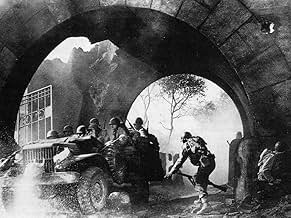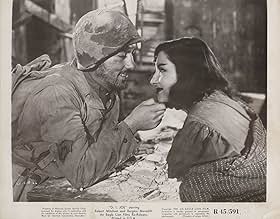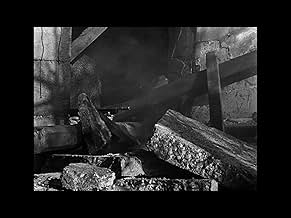CALIFICACIÓN DE IMDb
7.2/10
4.1 k
TU CALIFICACIÓN
Al final de la Segunda Guerra Mundial, el corresponsal de guerra Ernie Pyle, ganador del Premio Pulitzer, viaja con la División de la Compañía C del Ejército de los Estados Unidos durante la... Leer todoAl final de la Segunda Guerra Mundial, el corresponsal de guerra Ernie Pyle, ganador del Premio Pulitzer, viaja con la División de la Compañía C del Ejército de los Estados Unidos durante la liberación de Italia.Al final de la Segunda Guerra Mundial, el corresponsal de guerra Ernie Pyle, ganador del Premio Pulitzer, viaja con la División de la Compañía C del Ejército de los Estados Unidos durante la liberación de Italia.
- Dirección
- Guionistas
- Elenco
- Nominado a 4 premios Óscar
- 5 premios ganados y 8 nominaciones en total
John R. Reilly
- Private Murphy
- (as Jack Reilly)
William Murphy
- Private Mew
- (as Bill Murphy)
William 'Billy' Benedict
- Pvt. Whitey
- (sin créditos)
Michael Browne
- Sergeant
- (sin créditos)
Dorothy Coonan Wellman
- Nurse Lt. Elizabeth 'Red' Murphy
- (sin créditos)
Bob Hope
- Bob Hope (Voice on Radio Program)
- (voz)
- (sin créditos)
Kenneth Kendall
- Extra
- (sin créditos)
Yolanda Lacca
- Amelia, Italian Girl
- (sin créditos)
Barney Noto
- Staff Sergeant Barney Noto
- (sin créditos)
Tito Renaldo
- Lopez
- (sin créditos)
Dick Rich
- Sergeant at Showers
- (sin créditos)
William Self
- Pvt. Cookie Henderson
- (sin créditos)
Opiniones destacadas
It's odd that a director noted for his aviation films would choose to direct a film about the infantry, but William Wellman knew a great subject when he saw it. Remember he also did the deservedly highly acclaimed Battleground.
Independent producer Lucas Cowen got together with Ernie Pyle and approached Wellman. They left copies of the stories Pyle wrote from the front in Africa and Italy and Wellman read them in a night's sitting and agreed to do the film.
The Story of GI Joe is based on the various stories and characters that World War II's most famous correspondent encountered. In fact aside from Robert Mitchum and a couple of other actors, the men in this film are real GIs who were in transit from the European to the Pacific Theater and a lot were killed after they arrived in the Pacific as did the real Ernie Pyle who never got to see the finished product.
Burgess Meredith does a fine job recreating the modest chronicler that was Ernie Pyle. In civilian life aside from news stories, Pyle was famous for his cross country travels and stories he wrote about people from all walks of life. Very much like the late television commentator Charles Kuralt did on CBS morning news on Sundays.
When war broke out Pyle did not cover the war of the generals, he spent his time with the troops and told their story. For that he was respected and beloved as now other war correspondent has ever been before or since. In this film Pyle is introduced to the men of one company which transports him to that first American battle and defeat at Kasserine Pass in north Africa. And he runs into them again and again through Sicily right to the liberation of Rome.
Robert Mitchum plays the lieutenant later captain in charge of this company. He'd broken into films with some Hopalong Cassidy pictures and did bits in other films. In fact when its cowboy star Tim Holt enlisted in the armed forces, RKO pictures had signed Mitchum to be his replacement and he'd done two films Nevada and West of the Pecos when he read for the part of Lieutenant Walker.
If it weren't for this film, Robert Mitchum might have continued to be a B picture cowboy star. For his portrayal of the stern, but compassionate officer in whom Pyle finds a kindred spirit, Robert Mitchum got his only Academy Award nomination for Best Supporting Actor. He lost that year to James Dunn for A Tree Grows in Brooklyn. He never received another nomination, but he certainly became a legend although he'd have been the first to debunk that title.
Lots of newsreel footage from the Mediterranean theater make The Story of GI Joe one of the most realistic war films ever done. That's remarkable too, considering most of the Hollywood product back then was propaganda hype, good and bad. It has remained a classic to this day and a wonderful tribute to that chronicler of the infantry, Ernie Pyle.
Independent producer Lucas Cowen got together with Ernie Pyle and approached Wellman. They left copies of the stories Pyle wrote from the front in Africa and Italy and Wellman read them in a night's sitting and agreed to do the film.
The Story of GI Joe is based on the various stories and characters that World War II's most famous correspondent encountered. In fact aside from Robert Mitchum and a couple of other actors, the men in this film are real GIs who were in transit from the European to the Pacific Theater and a lot were killed after they arrived in the Pacific as did the real Ernie Pyle who never got to see the finished product.
Burgess Meredith does a fine job recreating the modest chronicler that was Ernie Pyle. In civilian life aside from news stories, Pyle was famous for his cross country travels and stories he wrote about people from all walks of life. Very much like the late television commentator Charles Kuralt did on CBS morning news on Sundays.
When war broke out Pyle did not cover the war of the generals, he spent his time with the troops and told their story. For that he was respected and beloved as now other war correspondent has ever been before or since. In this film Pyle is introduced to the men of one company which transports him to that first American battle and defeat at Kasserine Pass in north Africa. And he runs into them again and again through Sicily right to the liberation of Rome.
Robert Mitchum plays the lieutenant later captain in charge of this company. He'd broken into films with some Hopalong Cassidy pictures and did bits in other films. In fact when its cowboy star Tim Holt enlisted in the armed forces, RKO pictures had signed Mitchum to be his replacement and he'd done two films Nevada and West of the Pecos when he read for the part of Lieutenant Walker.
If it weren't for this film, Robert Mitchum might have continued to be a B picture cowboy star. For his portrayal of the stern, but compassionate officer in whom Pyle finds a kindred spirit, Robert Mitchum got his only Academy Award nomination for Best Supporting Actor. He lost that year to James Dunn for A Tree Grows in Brooklyn. He never received another nomination, but he certainly became a legend although he'd have been the first to debunk that title.
Lots of newsreel footage from the Mediterranean theater make The Story of GI Joe one of the most realistic war films ever done. That's remarkable too, considering most of the Hollywood product back then was propaganda hype, good and bad. It has remained a classic to this day and a wonderful tribute to that chronicler of the infantry, Ernie Pyle.
I found this to be a particularly poignant film about WWII - no heroics, just the simple getting through the day & night of a company of US infantry. Much like Ernie Pyle humanized the 'G. I.' in his written pieces, Wellman does the same on film. The heat, dirt, cold, mud, rain...fear, uncertainty, waste - it's all here without the bombast and manipulation of "Saving Private Ryan'. The performances are wonderful - most of the performances were given not by professionals but by the soldiers themselves. There is one scene between Mitchum and Meredith that was apparently an audition film - it was so right, it was simply inserted into the film. There are human touches throughout, as well as the insanity of war. I would strongly recommend this film to anyone who has an appreciation for the director, actors, theme. It's not a grisly film, and it is slow, but overall well worth watching.
The Story of G.I. Joe chronicles the experiences of an infantry unit in Italy as told by war correspondent Ernie Pyle, who is played by Burgess Meredith. War weary Robert Mitchum plays the platoon leader. While we can see that the movie was largely made in the studio, the great photography and direction move it along. Cold feet, mud, frustration, and homesickness are effectively demonstrated at the expense of battle scenes.
And war was fought in the rain and the mud and the cold....In today's wars fought on film there is very rarely a look at the true living conditions that existed. This movie does not clean up the actors (as most films do). You see here all of the gritty, day-to-day, living during the war. These guys did not clean up every day. This is a good story about WW2. Be sure to see it. 8/10
One of the most fascinating tributes to the foot soldier is this 1945 war film that follows Ernie Pyle, beloved war correspondent, as he treks along through mud and ambushes with a platoon of weary G.I. Joes.
Robert Mitchum earned an Oscar nomination as Lt. Bill Walker and many of the other males in the cast were real combat soldiers who actually participated in the making of the film. The plot is no more than a series of skirmishes the platoon faces on a mission against Nazis in Italy. Burgess Meredith makes Ernie Pyle a likeable human being who wins the trust and affection of the platoon as he trudges with them across marshlands and all of the "up front" activity involved.
Human touches abound without the emphasis on cliches that often abound in war films. Mitchum gives just the right touch to his role as the leader who understands the strain his soldiers are under. The inclusion of a sub-plot involving a soldier anxious to hear the sound of his son's voice on a recording; and a pooch that becomes the mascot for the troops, are touches that give the film added humanity.
There is some editing that seems a bit jumpy in the latter part of the film, as though some cuts were made--but all in all this is a very watchable war film with a close-up look at the men and their courage under fire. A fine tribute also to Ernie Pyle, a famous Pulitzer Prize-winning war correspondent during the dark days of World War II. Highly recommended.
Robert Mitchum earned an Oscar nomination as Lt. Bill Walker and many of the other males in the cast were real combat soldiers who actually participated in the making of the film. The plot is no more than a series of skirmishes the platoon faces on a mission against Nazis in Italy. Burgess Meredith makes Ernie Pyle a likeable human being who wins the trust and affection of the platoon as he trudges with them across marshlands and all of the "up front" activity involved.
Human touches abound without the emphasis on cliches that often abound in war films. Mitchum gives just the right touch to his role as the leader who understands the strain his soldiers are under. The inclusion of a sub-plot involving a soldier anxious to hear the sound of his son's voice on a recording; and a pooch that becomes the mascot for the troops, are touches that give the film added humanity.
There is some editing that seems a bit jumpy in the latter part of the film, as though some cuts were made--but all in all this is a very watchable war film with a close-up look at the men and their courage under fire. A fine tribute also to Ernie Pyle, a famous Pulitzer Prize-winning war correspondent during the dark days of World War II. Highly recommended.
¿Sabías que…?
- TriviaThe extras in the film were real American GIs, in the process of being transferred from the war in Europe to the Pacific. Many of them were killed in the fighting on Okinawa--the same battle in which Ernie Pyle was killed by a Japanese machine gunner--never having seen the movie in which they appeared.
- ErroresThe unit Pyle is with--the 18th Infantry Regiment, 1st Infantry Division--never fought in the Italian campaign. After the Sicilian campaign ended, it was brought back to England and began training for the D-Day invasion in Normandy. The 1st Division would eventually spearhead the assault on Omaha Beach.
- Citas
Pvt. Dondaro: If this War don't kill me first, my feet will.
- Créditos curiososThere are absolutely no credits at the end of the film, not even the words "The End".
- ConexionesEdited from San Pietro (1945)
- Bandas sonorasSilent Night
(uncredited)
Music by Franz Xaver Gruber
Lyrics by Joseph Mohr
Sung by Elfie Mayerhofer on Decca Record
Selecciones populares
Inicia sesión para calificar y agrega a la lista de videos para obtener recomendaciones personalizadas
- How long is Story of G.I. Joe?Con tecnología de Alexa
Detalles
- Fecha de lanzamiento
- País de origen
- Idiomas
- También se conoce como
- Story of G.I. Joe
- Locaciones de filmación
- Iverson Ranch - 1 Iverson Lane, Chatsworth, Los Ángeles, California, Estados Unidos(marching through countryside just before the "baptism of fire.")
- Productora
- Ver más créditos de la compañía en IMDbPro
Taquilla
- Presupuesto
- USD 1,000,000 (estimado)
- Tiempo de ejecución1 hora 48 minutos
- Color
- Relación de aspecto
- 1.37 : 1
Contribuir a esta página
Sugiere una edición o agrega el contenido que falta

Principales brechas de datos
By what name was También somos seres humanos (1945) officially released in India in English?
Responda






























